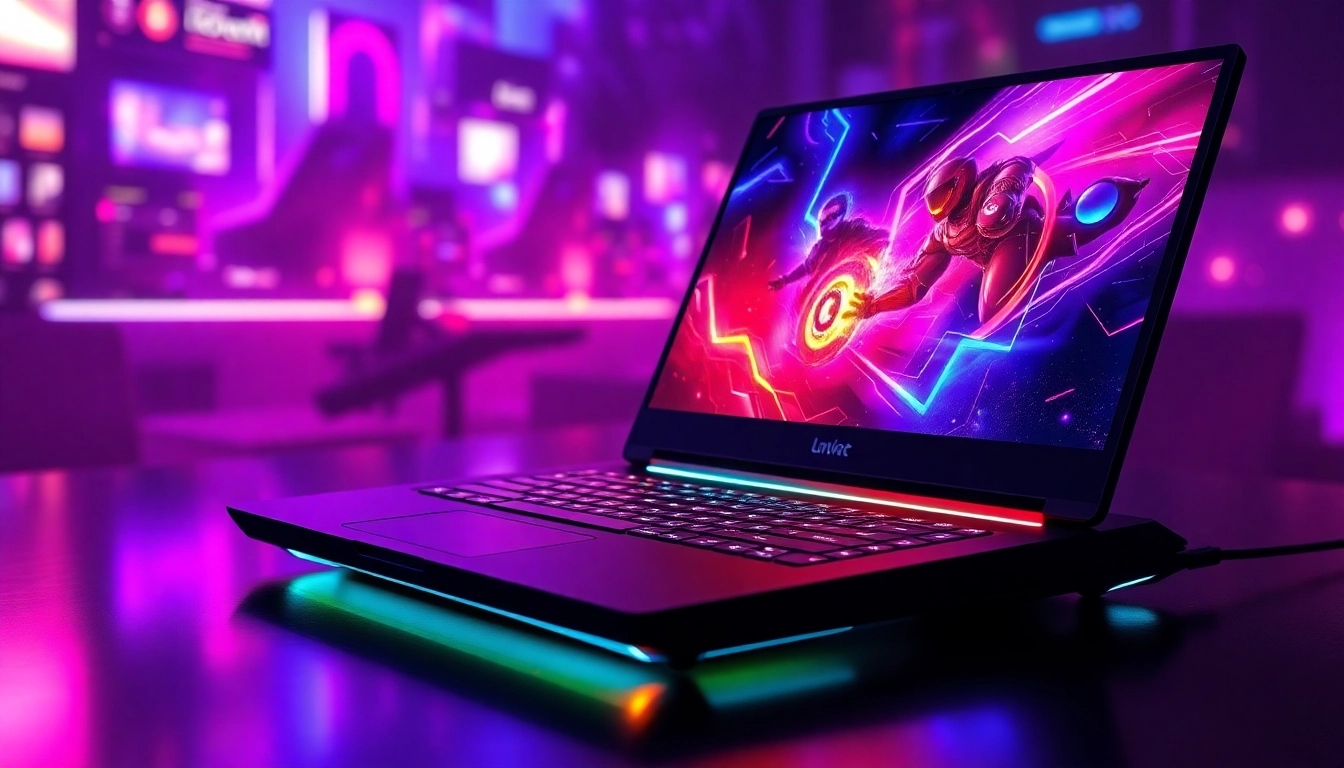Understanding Gaming Laptops: Features and Technologies
Gaming laptops have revolutionized the way enthusiasts approach PC gaming, combining portability with high-end performance. Unlike traditional laptops, gaming models incorporate cutting-edge hardware, advanced display technologies, and sophisticated cooling systems to deliver an immersive gaming experience on the go. For avid gamers and content creators alike, selecting the right gaming laptop involves understanding key hardware components, innovative display features, and performance optimization techniques. To explore a wide array of options and find the best fit for your needs, visit Gaming Laptops on our platform for a curated collection of the latest gaming equipment.
Key Hardware Components for Gaming
At the heart of any gaming laptop are its hardware components. High-performance processors, dedicated graphics cards, ample memory, and fast storage solutions are essential to handle demanding titles and intensive creative workflows.
Processors (CPU)
Modern gaming laptops feature processors like Intel’s Core Ultra 9 Series 2, boasting up to 24 cores and turbo speeds exceeding 5.4GHz, or AMD’s Ryzen 7 and Ryzen 9 series with upwards of 16 cores. These CPUs facilitate multitasking, streaming, and complex computations seamlessly. Notably, the Intel Core Ultra 9-275HX Series 2 is designed specifically for next-generation gaming and content creation, enabling smarter power management with integrated AI acceleration via onboard Neural Processing Units (NPUs).
Graphics Cards (GPU)
Graphics performance is pivotal in gaming laptops. NVIDIA’s latest architectures, such as the Blackwell-based GeForce RTX 5070 and RTX 5060 series, deliver real-time ray tracing, AI-enhanced rendering with DLSS 4, and ultra-responsive gameplay features like NVIDIA Reflex 2. These GPUs support high-resolution gaming and immersive visual effects, making them ideal for both competitive eSports and cinematic-quality storytelling.
Memory (RAM)
To support multitasking and high-demand tasks, gaming laptops now come equipped with at least 16GB of DDR4 or DDR5 RAM, with high-end models offering 64GB DDR5-5600MHz configurations. Larger memory buffers reduce latency, allow for more intensive applications, and improve overall responsiveness during gaming or content creation.
Storage Solutions
Speedy storage options like NVMe SSDs ensure quick load times and seamless game streaming. Many flagship devices feature up to 4TB PCIe 4.0 SSDs, accommodating extensive game libraries, large media files, and active projects. This combination of capacities and speeds is crucial for modern gaming and professional workflows.
Display Technologies and Refresh Rates
A gaming laptop’s display is its window to the virtual world. High refresh rates, versatile resolutions, and color fidelity significantly influence gameplay quality and visual immersion.
Refresh Rates and Response Times
Key to fluid gameplay, refresh rates range from 120Hz to an impressive 480Hz in premium models like the ASUS ROG Strix G16 or Alienware X17 R2. Faster refresh rates reduce motion blur and tearing, especially in fast-paced titles such as first-person shooters or racing games. Response times, often 3ms or less, further minimize ghosting effects, creating sharper images in high-speed scenes.
Resolution and Color Coverage
Displays with resolutions such as WQXGA (2560 x 1600) and UHD offer crisp visuals with vibrant detail. For example, the Alienware 16x Aurora features a 16” WQXGA display with 100% DCI-P3 color coverage, ensuring accurate hues and vibrant imagery. Technologies like NVIDIA G-SYNC and Advanced Optimus synchronize frame rates with GPU output to eliminate tearing, creating ultra-smooth gameplay experiences. Additionally, features like ComfortView Plus help reduce blue light exposure over extended gaming sessions, promoting healthier viewing.
Color Fidelity and HDR
Gamers and creators demand high color accuracy. With 100% sRGB or DCI-P3 coverage, modern gaming laptops ensure vibrant, true-to-life visuals. Some models also support HDR technologies, enhancing contrast and dynamic range for cinematic effects.
Advanced Cooling and Noise Management
Intensive gaming sessions generate significant heat, which can compromise performance, hardware lifespan, and comfort. To address these challenges, top-tier gaming laptops incorporate sophisticated cooling solutions, including liquid cooling, multiple fan systems, and optimized airflow designs.
Liquid Cooling Systems
Devices like the Alienware R16 Raptor feature up to a 240mm heat exchanger, allowing sustained high performance without thermal throttling. Liquid cooling keeps key components at ideal temperatures, reduces noise, and maintains system stability during prolonged gameplay.
Multiple Fan and Heat Pipe Designs
Quad fan cooling systems, along with larger heat pipes, ensure effective heat dispersion. These systems operate quietly at lower RPMs, minimizing distractions while gaming. Proper internal cable management and increased airflow passageways further enhance thermal efficiency, keeping critical components like GPUs and CPUs cool under load.
Noise Level Management
Advanced fan control algorithms and custom profiles help balance cooling performance with noise levels, ensuring quieter operation during casual gaming or streaming. This is essential for maintaining focus and comfort during hours-long gaming marathons.
Choosing the Right Gaming Laptop for Your Needs
Selecting the optimal gaming laptop depends on your budget, performance expectations, portability needs, and specific use cases. Here’s a comprehensive guide to help you navigate the decision-making process.
Performance Tiers and Budget Considerations
Entry-level gaming laptops start around $800, offering mid-range processors and GPUs suitable for casual gaming. Mid-tier models, priced between $1200–$2000, balance performance with portability and include high-refresh-rate displays and larger RAM. For enthusiasts and professionals, high-end models like the Alienware Aurora R16 or R18 series provide premium processors, RTX 5080 graphics, and expansive storage, often exceeding $3000. Comparing features and evaluating what you need most will help you allocate your investment wisely.
Brand Comparison and Feature Highlights
Leading brands such as Alienware, ASUS ROG, MSI, Lenovo Legion, and Acer Predator each have unique strengths. Alienware’s flagship models like the Area-51 and m15 R6 focus on premium build quality, high-end specs, and immersive displays. ASUS ROG G16 and Zephyrus series excel in ultra-fast refresh rates and innovative cooling. MSI’s Titan and Stealth lineup balance performance and portability with customizable options. Evaluating these brands based on specific features like keyboard lighting, port selections, and software ecosystem will guide better choices.
Portability vs. Power: Finding Your Balance
High-performance gaming laptops tend to be bulky due to powerful cooling systems and hardware. However, models like the ASUS ROG Zephyrus or MSI Stealth aim for a sleek design without sacrificing performance. If mobility is critical, prioritize lighter models with high refresh rates, while if maximum performance is your goal, opting for larger, more robust systems like the Alienware Area-51 might be ideal. Understanding your primary use case—whether gaming, streaming, or content creation—will help you strike the right balance.
Optimizing Gaming Performance
Beyond choosing the right hardware, optimizing software settings and upgrading components can significantly enhance your gaming experience.
Configuring Settings for Smooth Gameplay
Adjust in-game graphics settings such as resolution, detail levels, and anti-aliasing to balance visual quality with frame rates. Use technologies like NVIDIA DLSS to boost frame rates at higher resolutions. Enabling G-SYNC or FreeSync reduces tearing, while optimizing power profiles ensures maximum performance without overheating.
Upgrading and Customizing Your Laptop
Many gaming laptops support hardware upgrades like adding more RAM or replacing storage drives. For example, upgrading from 16GB to 64GB DDR5 memory can benefit content creators, while swapping out an SSD can improve load times. However, check your model’s upgradeability options, as some ultra-slim designs have limited internal access.
Software and Driver Optimization Tips
Keep your GPU drivers updated via manufacturer tools like NVIDIA GeForce Experience. Disable background applications that consume resources, and utilize gaming modes in Windows 11 for prioritizing gaming traffic. Regularly running system maintenance tools guarantees stability and peak performance during intense gaming sessions.
Latest Trends in Gaming Laptop Technology
The gaming laptop industry continually pushes forward with innovations aimed at neural processing, display fidelity, and future-proofing. Staying updated ensures your setup can handle upcoming titles and technological shifts.
Emerging Processor and GPU Innovations
Next-generation CPUs like Intel’s 14th Gen i9-14900HX and AMD’s Ryzen 7000 series bring increased core counts, better energy efficiency, and AI integration. Simultaneously, GPUs based on NVIDIA’s Blackwell architecture incorporate enhanced ray tracing, DLSS 4, and AI-powered rendering that push visual realism and frame rates to new heights.
Display Enhancements and Visual Fidelity
Displays now feature higher refresh rates up to 480Hz, greater color accuracy, and HDR support — delivering immersive visuals in fast-paced games. High-resolution, mini-LED backlit screens, and wider color gamuts like DCI-P3 are becoming standard, enriching the gaming and creative experience.
Future-Proofing Your Gaming Setup
Investing in systems with upgradeable components, support for Wi-Fi 6E or Wi-Fi 7, and compatibility with emerging VR/AR technologies ensures longevity. Logical choices include models with ample RAM, multiple M.2 slots for storage expansion, and support for higher bandwidth connections to keep pace with technological advancements.
Having Fun with Gaming Laptops: Accessories and Peripherals
Maximizing your gaming experience isn’t just about the core system. Quality peripherals and accessories enhance gameplay, comfort, and aesthetic appeal.
Top Gaming Mice, Keyboards, and Headsets
The right gaming mouse, such as the ASUS ROG Chakram X with tri-mode connectivity and customizable buttons, provides precision and flexibility. Mechanical keyboards like the Corsair K70 PRO or Razer BlackWidow V3 Mini offer tactile feedback and durability for long hours. High-fidelity headsets from ASUS or Razer immerse gamers with 3D positional audio, noise cancellation, and comfort for extended sessions.
RGB and Aesthetic Enhancements
RGB lighting peripherals elevate setup aesthetics. With vibrant color schemes, synchronized lighting effects, and customizable profiles, these devices complement gaming laptops’ internal RGB lighting, creating a cohesive and dynamic environment. Showcase your style in live streams or gaming battles with gear from brands like ASUS TUF or Corsair.
Stream, Record, and Content Creation Tips
Leverage powerful CPUs and GPUs for streaming gameplay directly from your laptop. Utilize built-in overlays, scene switching, and professional microphones for high-quality content. Maintaining a tidy workspace with cable management and variable lighting enhances the overall experience for viewers and streamers alike.



